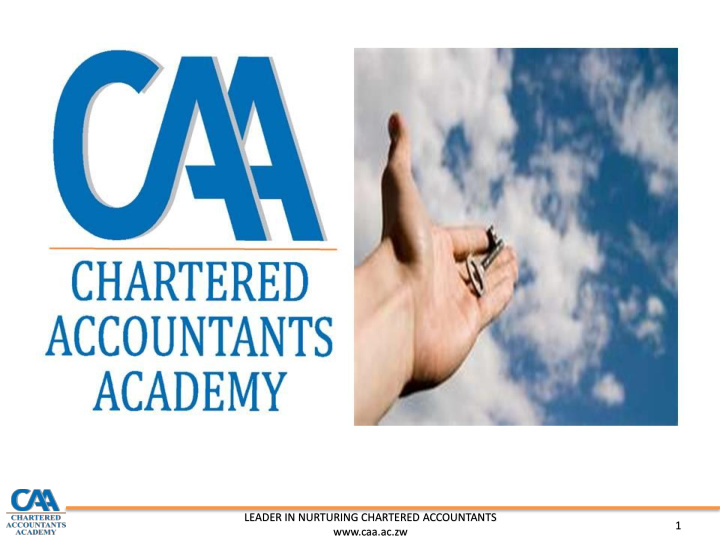



LEADER IN NURTURING CHARTERED ACCOUNTANTS 1 www.caa.ac.zw
UNISA SUPPLEMENTARY PREPARATION LEADER IN NURTURING CHARTERED ACCOUNTANTS 2 www.caa.ac.zw
Testing Model Final exam overview Focus areas Common pitfalls LEADER IN NURTURING CHARTERED ACCOUNTANTS 3 www.caa.ac.zw
Testing Model Subject matter is the body of knowledge you already posses. Ability to understand the context of the Scenario and deciphering the Required Applying the knowledge you have to answer the required within the context of the scenario. LEADER IN NURTURING CHARTERED ACCOUNTANTS 4 www.caa.ac.zw
Exam Overview • Main issue was understanding the scenario and the context. • Main pitfalls: – Thinking that CCT was a partnership – Failure to apply basic knowledge – Lack of knowledge of some specific sections – Failure to follow instructions – Ability to discuss VAT LEADER IN NURTURING CHARTERED ACCOUNTANTS 5 www.caa.ac.zw
Focus Areas • Please review the following areas during your preparation for the exam. • Note these areas are not the exam but simply the areas that we feel students are weakest in and need specific attention. • The following slides will be in point form and are meant to point you towards the area to study and are not a replacement of content. LEADER IN NURTURING CHARTERED ACCOUNTANTS 6 www.caa.ac.zw
• Gross Income – Applying the general definition • Source • Deemed source • Capital in nature – Common pitfalls • Not picking up the type of income and applying true source principle • Lack of knowledge of specific provisions and using the word deemed unnecessarily • Ability to apply the Capital in nature principles of compensatory or non-compensatory income LEADER IN NURTURING CHARTERED ACCOUNTANTS 7 www.caa.ac.zw
• General Deduction – Applying the general formulae • Production of income/purpose of trade • Capital in nature – Common pitfalls • Inability to discuss purpose of trade and confusing arguments with capital in nature arguments • Inability to articulate capital in nature principles for deductions e.g using enduring benefit or fixed or floating capital principles • Discussing deductibility of interest expense • Differences between a tax credit and a deduction LEADER IN NURTURING CHARTERED ACCOUNTANTS 8 www.caa.ac.zw
• Capital gains tax – Capital allowances and the number of years used – Inflation allowance and the number of years used – Types of specified assets and the specific provisions for the assets – The deferment and reliefs applicable to taxpayers • Employment Income – When elderly credits are applicable – Other credits – Pensions, RAF’s and benefit funds • Commutation • Annuities • Exemptions LEADER IN NURTURING CHARTERED ACCOUNTANTS 9 www.caa.ac.zw
• VAT – Output tax • Supply/trade • Rate • Time of supply • Value of supply – Input tax • Where you charged? • Are you making taxable supplies? – Adjustment, knowing the specific provisions LEADER IN NURTURING ACCOUNTANTS 10 www.caa.ac.zw
VAT cont. • Common pitfalls – Using input tax to determine whether output tax should be charged. – Completeness of output tax discussion i.e. not discussing time and value of supply for output tax – Not being able to break a transaction into its component parts and discussing each component LEADER IN NURTURING CHARTERED ACCOUNTANTS 11 www.caa.ac.zw
Specialised tax payers • Deceased estates – section 11 – Determine if income is from an asset in a deceased estate s11(1) – Determine when the right to claim the amount arose and when the amount is due and payable • Amount due pre-death and right in the lifetime = income in deceased estate s11(4)(b) • No right in life time and gratuitous amount = not income in deceased estate s11(4)(c) • Due post death = income in deceased estate – LEADER IN NURTURING CHARTERED ACCOUNTANTS 12 www.caa.ac.zw
Cont. • Farmers and Miners – Treatment of capital allowances – Treatment of capital expenditure – Specific reliefs eg drought relief • Partnerships – Deeming provision s10(2) – Separation between the partnership and the individual income. LEADER IN NURTURING CHARTERED ACCOUNTANTS 13 www.caa.ac.zw
General Pointers • Be aware of how tax planning can be applied • Always be aware of anti – avoidance legislation and areas where they may be tax avoidance. LEADER IN NURTURING CHARTERED ACCOUNTANTS 14 www.caa.ac.zw
LEADER IN NURTURING CHARTERED ACCOUNTANTS 15 www.caa.ac.zw
Recommend
More recommend